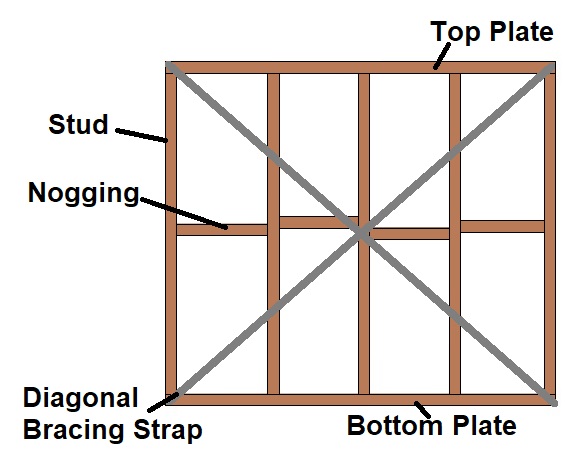When talking about Timber frame panels, most of us are not quite sure how they are built. Another concern is thinking about what parts should be considered to build durable and efficient timber frame walls. Still, it is a necessity to know the basics of construction using Timber panels, so you can have a good home that’s built with strength amidst environmental and structural circumstances.
Timber Frame Terminology
Timber frame dimensions in Australia are set at 70mm to 90mm deep, with a timber stud thickness of 35mm to 45mm. In having a Timber Frame Panel, you need to remember its important parts:
- Studs
- Top Plate
- Bottom Plate
- Noggings
- Diagonal Bracing Straps
Studs
The studs are the main component of a Timber frame panel as they mainly support the vertical load of the upper floors and walls. They are placed between the top and bottom panels and are equally spaced to provide durability and withstand weight when used for walls, window frames, or even doors. Hence, they are the foundation of the Timber frames, controlling and preventing the structure of your house from breaking down and giving efficient lateral support.
Moreover, the standard wall stud placing in Australia is at 450mm for external walls, and 600mm for internal walls. Yet, they can also vary depending on the structural reasons, considering the weight of the structure it is supporting.
Top Plate
Building a timber frame wall isn’t complete without the presence of the Top Plate. They act as a mounting for the structure of the top timber frame, and they help carry the weight of the wall structure above the studs. Discover detailed Kubota specifications that ensure you choose the right equipment for any project.
The top plate works hand in hand with the studs to carry loads. However, to build a nicely structured internal framing timber, you may always opt to double the top frame panels so it could be highly durable and help to carry the weight above it. If you have roof trusses and floor beams above the timber frame, it is recommended to put two top plates directly above the studs to ensure better frame hold and weight resistance.
Bottom Plate
The bottom panel is the one responsible to hold the studs on the base and positions the whole of the frame to level it. Consequently, it is necessary to level the studs off, to further avoid a crooked timber wall frame and erect it to a perfect position. Thus, they control the placement of the studs, giving it a nice finish and avoid movements when the frame is done.
Noggings
It is not enough to just place studs for the frame to stand as strong as it is ought to be. With this, noggings are placed between the studs, as they can prevent them from warping or bending when weights are placed on the frames.
The standard nogging distance should be at 1350mm between the top and bottom frames and is to be doubled when the wall is higher than 2.74m. Nevertheless, it is completely fine to have a single nogging when the wall is less than 2.74m.
Diagonal Bracing Strap
Diagonal Bracing Straps are the ones responsible for resisting diagonal weights. They are placed like an “x” between each other, the top end on the left side and the bottom end on the opposite side and vice versa. These straps are also a way to avoid deformation and resist diagonal weights like wind loading.
Straps can be skipped for the frames, but they also protect the studs and acts as an additional substructure to keep the overall efficiency and strength of the timber frames.
Timber frames are a good way to give more insulation to your home. Aside from the natural look it gives, they may be used by homeowners to be cost-efficient with home construction than having a concrete or steel framing that may require so much time and materials just to be erected. Moreover, it has a positive environmental impact as well, since it requires less to no fossil fuels to get an eco-friendly home.
Thinking of using Timber Frames? Having these precise and traditional construction designs can surely provide your home sweet home a snug, energy-efficient atmosphere.
While timber frames offer excellent insulation and a charming, natural aesthetic, maintaining their appearance requires the right paint and finish. A well-applied coat of paint not only enhances the look but also provides crucial protection against moisture, pests, and UV damage.
For homeowners or businesses looking to preserve the beauty and durability of their timber structures, working with a Commercial Painting Company in Illinois ensures that every surface is treated with precision and care, using high-quality, weather-resistant coatings.
Beyond aesthetics, a professional paint job can significantly extend the lifespan of wooden frames, preventing warping, cracking, and rot. Whether it’s a rustic cabin or a modern commercial building, investing in the right painting services can make a noticeable difference in both appearance and performance.
Experienced painters in Illinois specialize in techniques that safeguard timber while maintaining its natural warmth and character, ensuring that every structure remains a standout for years to come.




I just found a old pack of in-cred-i bites, berry flavour !
Wow, I’d love to add an image to my original article if you still have them: https://anicehome.com.au/keith/popular-australian-lunchbox-school-yard-snacks-from-the-1990s/